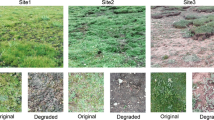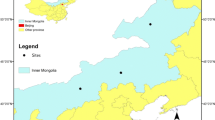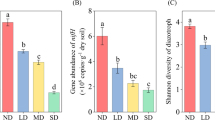Abstract
Purpose
Knowledge of soil N cycling and the associated functional microbial groups of N2O production under different management measures could provide clues for the restoration of degraded meadows in alpine ecosystems.
Materials and methods
We investigated soil N2O emissions, the genes related to N2O production and reduction (AOA-amoA, AOB-amoA, nirK, nirS, and nosZ), and associated microbial communities in four meadows (continuous grazing, grazing exclusion by fencing, grazing exclusion by combined fencing and reseeding, and undisturbed meadow) in the Tibetan Plateau to reveal the mechanism underlying potential N2O emissions in alpine meadows.
Results and discussion
Compared to the grazing meadow, fencing and fencing + reseeding meadows had lower N2O emissions and lower abundances of AOA-amoA, AOB-amoA, nirK, nirS, and nosZ genes, suggesting that grazing exclusion could decrease the soil N-turnover potential. However, the higher N2O emissions compared to those of undisturbed meadows indicated that longer restoration periods were necessary. Seeding the fenced meadow did not alter soil N2O emission or the abundance of AOA-amoA, AOB-amoA, nirK, nirS, and nosZ genes, possibly owing to the similar soil nutrient status compared to that of the fencing meadow. Grazing exclusion also resulted in significant changes in the community diversity and composition of microbes harboring these functional genes, especially nirK and nosZ communities. N2O emissions were significantly associated with microbial communities involved in N2O production and reduction but not with the gene abundance of AOA-amoA, AOB-amoA, nirK, nirS, and nosZ. Soil dissolved organic nutrients, including C and N, and soil moisture were the controlling factors for N2O production by altering the community composition of nirK- and nosZ-type denitrifiers, such as Bradyrhizobiaceae, Rhizobiaceae, Brucellaceae, Ochrobactrum, and Proteobacteria.
Conclusions
Our results indicated that grazing-induced elevation of potential N2O emissions from meadow soil could be alleviated by grazing exclusion, including sole fencing and a combination of fencing and reseeding, by changing soil dissolved organic nutrients and moisture thus regulating the microbial communities.








Similar content being viewed by others
References
Aamer MS, M H, M U, Huang GQ, Liu Y, Tang HY, Rasul F, Ma QY, Li ZL, Rasheed A, Peng Z, (2020) Biochar mitigates the N2O emissions from acidic soil by increasing the nosZ and nirK gene abundance and soil pH. J Environ Manage 255:7
Akiyama H, Hoshino YT, Itakura M, Shimomura Y, Wang Y, Yamamoto A, Tago K, Nakajima Y, Minamisawa K, Hayatsu M (2016) Mitigation of soil N2O emission by inoculation with a mixed culture of indigenous Bradyrhizobium diazoefficiens. Sci Rep 6:8
Brenzinger K, Dorsch P, Braker G (2015) pH-driven shifts in overall and transcriptionally active denitrifiers control gaseous product stoichiometry in growth experiments with extracted bacteria from soil. Front Microbiol 6:11
Brucek P, Simek M, Hynst J (2009) Long-term animal impact modifies potential production of N2O from pasture soil. Biol Fertil Soils 46:27–36
Cai Y, Wang X, Tian L, Zhao H, Lu X, Yan Y (2014) The impact of excretal returns from yak and Tibetan sheep dung on nitrous oxide emissions in an alpine steppe on the Qinghai-Tibetan Plateau. Soil Biol Biochem 76:90–99
Cai YJ, Chang SX, Ma B, Bork EW (2016) Watering increased DOC concentration but decreased N2O emission from a mixed grassland soil under different defoliation regimes. Biol Fertil Soils 52:987–996
Cao Y, He Z, Zhu T, Zhao F (2021) Organic-C quality as a key driver of microbial nitrogen immobilization in soil: a meta-analysis. Geoderma 383:114784
Chen H, Zhu Q, Peng C, Wu N, Wang Y, Fang X, Gao Y, Zhu D, Yang G, Tian J, Kang X, Piao S, Ouyang H, Xiang W, Luo Z, Jiang H, Song X, Zhang Y, Yu G, Zhao X, Gong P, Yao T, Wu J (2013) The impacts of climate change and human activities on biogeochemical cycles on the Qinghai-Tibetan Plateau. Glob Chang Biol 19:2940–2955
Chen Z, Wang Q, Zhao J, Chen Y, Wang H, Ma J, Zou P, Bao L (2020) Restricted nitrous oxide emissions by ammonia oxidizers in two agricultural soils following excessive urea fertilization. J Soils Sediments 20:1502–1512
Cui Y, Wang X, Zhang X, Ju W, Duan C, Guo X, Wang Y, Fang L (2020) Soil moisture mediates microbial carbon and phosphorus metabolism during vegetation succession in a semiarid region. Soil Biol Biochem 147:107814
Delgado-Baquerizo M, Oliverio AM, Brewer TE, Benavent-Gonzalez A, Eldridge DJ, Bardgett RD, Maestre FT, Singh BK, Fierer N (2018) A global atlas of the dominant bacteria found in soil. Science 359:320–325
Fan FL, Yin C, Tang YJ, Li ZJ, Song A, Wakelin SA, Zou J, Liang YC (2014) Probing potential microbial coupling of carbon and nitrogen cycling during decomposition of maize residue by C-13-DNA-SIP. Soil Biol Biochem 70:12–21
Fan X, Yin C, Chen H, Ye M, Zhao Y, Li T, Wakelin SA, Liang Y (2019) The efficacy of 3,4-dimethylpyrazole phosphate on N2O emissions is linked to niche differentiation of ammonia oxidizing archaea and bacteria across four arable soils. Soil Biol Biochem 130:82–93
Fang WS, Yan DD, Huang B, Ren ZJ, Wang XL, Liu XM, Li Y, Ouyang CB, Migheli Q, Cao AC, Wang QX (2019) Biochemical pathways used by microorganisms to produce nitrous oxide emissions from soils fumigated with dimethyl disulfide or allyl isothiocyanate. Soil Biol Biochem 132:1–13
Feng ZJ, Sheng YQ, Cai F, Wang W, Zhu LZ (2018) Separated pathways for biochar to affect soil N2O emission under different moisture contents. Sci Total Environ 645:887–894
Fierer N, Jackson RB (2006) The diversity and biogeography of soil bacterial communities. Proc Natl Acad Sci U S A 103:626–631
Fish JA, Chai BL, Wang Q, Sun YN, Brown CT, Tiedje JM, Cole JR (2013) FunGene: the functional gene pipeline and repository. Front Microbiol 4:14
Fu QL, Xi RZ, Zhu J, Hu HQ, Xing ZQ, Zuo JC (2020) The relative contribution of ammonia oxidizing bacteria and archaea to N2O emission from two paddy soils with different fertilizer N sources: a microcosm study. Geoderma 375:12
Glenn EP, Jordan F, Waugh WJ (2017) Phytoremediation of a nitrogen-contaminated desert soil by native shrubs and microbial processes. Land Degrad Dev 28:361–369
Gu X, Wang Y, Laanbroek HJ, Xu X, Song B, Huo Y, Chen S, Li L, Zhang L (2019) Saturated N2O emission rates occur above the nitrogen deposition level predicted for the semi-arid grasslands of Inner Mongolia, China. Geoderma 341:18–25
Hall MKD, Winters AJ, Rogers GS (2014) Variations in the diurnal flux of greenhouse gases from soil and optimizing the sampling protocol for closed static chambers. Commun Soil Sci Plant Anal 45:2970–2978
Hallin S, Philippot L, Loffler FE, Sanford RA, Jones CM (2018) Genomics and ecology of novel N2O-reducing microorganisms. Trends Microbiol 26:43–55
Harter J, Krause HM, Schuettler S, Ruser R, Fromme M, Scholten T, Kappler A, Behrens S (2014) Linking N2O emissions from biochar-amended soil to the structure and function of the N-cycling microbial community. ISME J 8:660–674
Henry S, Baudoin E, Lopez-Gutierrez JC, Martin-Laurent F, Brauman A, Philippot L (2004) Quantification of denitrifying bacteria in soils by nirK gene targeted real-time PCR. J Microbiol Methods 59:327–335
Henry S, Texier S, Hallet S, Bru D, Dambreville C, Cheneby D, Bizouard F, Germon JC, Philippot L (2008) Disentangling the rhizosphere effect on nitrate reducers and denitrifiers: insight into the role of root exudates. Environ Microbiol 10:3082–3092
Huang R, Wang Y, Liu J, Li J, Xu G, Luo M, Xu C, Ci E, Gao M (2019) Variation in N2O emission and N2O related microbial functional genes in straw- and biochar-amended and non-amended soils. Appl Soil Ecol 137:57–68
Jones CM, Graf DRH, Bru D, Philippot L, Hallin S (2013) The unaccounted yet abundant nitrous oxide-reducing microbial community: a potential nitrous oxide sink. ISME J 7:417–426
Kooch Y, Moghimian N, Wirth S, Noghre N (2020) Effects of grazing management on leaf litter decomposition and soil microbial activities in northern Iranian rangeland. Geoderma 361
Kravchenko AN, Toosi ER, Guber AK, Ostrom NE, Yu J, Azeem K, Rivers ML, Robertson GP (2017) Hotspots of soil N2O emission enhanced through water absorption by plant residue. Nat Geosci 10:496–500
Levy-Booth DJ, Prescott CE, Grayston SJ (2014) Microbial functional genes involved in nitrogen fixation, nitrification and denitrification in forest ecosystems. Soil Biol Biochem 75:11–25
Li PP, Zhang SQ, Li F, Zhang YT, Han YL (2020) Long term combined fertilization and soil aggregate size on the denitrification and community of denitrifiers. Appl Soil Ecol 156:103718
Li Z, Li L, Xia S, Zhang R, Zhang R, Chen P, Pan J, Liu Y (2021) K fertilizer alleviates N2O emissions by regulating the abundance of nitrifying and denitrifying microbial communities in the soil-plant system. J Environ Manage 291:112579
Liu SB, Zamanian K, Schleuss PM, Zarebanadkouki M, Kuzyakov Y (2018) Degradation of Tibetan grasslands: consequences for carbon and nutrient cycles. Agric Ecosyst Environ 252:93–104
Mafa-Attoye TG, Baskerville, MA Ofosu E, Oelbermann M, Thevathasan NV, Dunfield, KE (2020) Riparian land-use systems impact soil microbial communities and nitrous oxide emissions in an agro-ecosystem. Sci Total Environ 724:138148
Mehnaz KR, Keitel C, Dijkstra FA (2019) Phosphorus availability and plants alter soil nitrogen retention and loss. Sci Total Environ 671:786–794
Miller MN, Zebarth BJ, Dandie CE, Burton DL, Goyer C, Trevors JT (2008) Crop residue influence on denitrification, N2O emissions and denitrifier community abundance in soil. Soil Biol Biochem 40:2553–2562
Morley N, Baggs EM (2010) Carbon and oxygen controls on N2O and N2 production during nitrate reduction. Soil Biol Biochem 42:1864–1871
Pahlavan-Rad MR, Dahmardeh K, Hadizadeh M, Keykha G, Mohammadnia N, Gangali M, Keikha M, Davatgar N, Brungard C (2020) Prediction of soil water infiltration using multiple linear regression and random forest in a dry flood plain, eastern Iran. Catena 194:104715
Prosser JI, Nicol GW (2012) Archaeal and bacterial ammonia-oxidisers in soil: the quest for niche specialisation and differentiation. Trends Microbiol 20:523–531
Qin H, Xing X, Tang Y, Zhu B, Wei X, Chen X, Liu Y (2020) Soil moisture and activity of nitrite- and nitrous oxide-reducing microbes enhanced nitrous oxide emissions in fallow paddy soils. Biol Fertil Soils 56:53–67
Rowlings DW, Grace PR, Scheer C, Liu S (2015) Rainfall variability drives interannual variation in N2O emissions from a humid, subtropical pasture. Sci Total Environ 512–513:8–18
Schloss PD, Westcott SL, Ryabin T, Hall JR, Hartmann M, Hollister EB, Lesniewski RA, Oakley BB, Parks DH, Robinson CJ, Sahl JW, Stres B, Thallinger GG, Van Horn DJ, Weber CF (2009) Introducing mothur: open-source, platform-independent, community-supported software for describing and comparing microbial communities. Appl Environ Microbiol 75:7537–7541
Seitzinger SP, Kroeze C (1998) Global distribution of nitrous oxide production and N inputs in freshwater and coastal marine ecosystems. Global Biogeochem Cy 12:93–113
Shaaban M, Wu YP, Khalid MS, Peng QA, Xu XY, Wu L, Younas A, Bashir S, Mo YL, Lin S, Zafar-ul-Hye M, Abid M, Hu RG (2018) Reduction in soil N2O emissions by pH manipulation and enhanced nosZ gene transcription under different water regimes. Environ Pollut 235:625–631
Song ZL, Wang J, Liu GB, Zhang C (2019) Changes in nitrogen functional genes in soil profiles of grassland under long-term grazing prohibition in a semiarid area. Sci Total Environ 673:92–101
Stone MM, Kan JJ, Plante AF (2015) Parent material and vegetation influence bacterial community structure and nitrogen functional genes along deep tropical soil profiles at the Luquillo Critical Zone Observatory. Soil Biol Biochem 80:273–282
Stow CA, Walker JT, Cardoch L, Spence P, Stow CA (2005) N2O emissions from streams in the Neuse River watershed, North Carolina. Environ Sci Technol 39:6999–7004
Sun S, Badgley BD (2019) Changes in microbial functional genes within the soil metagenome during forest ecosystem restoration. Soil Biol Biochem 135:163–172
Trivedi P, Leach JE, Tringe SG, Sa TM, Singh BK (2020) Plant-microbiome interactions: from community assembly to plant health. Nat Rev Microbiol 18:607–621
Tzanakakis VA, Taylor AE, Bakken LR, Bottomley PJ, Myrold DD, Dörsch P (2019) Relative activity of ammonia oxidizing archaea and bacteria determine nitrification-dependent N2O emissions in Oregon forest soils. Soil Biol Biochem 139:107612
Uchida Y, Clough TJ, Kelliher FM, Sherlock RR (2008) Effects of aggregate size, soil compaction, and bovine urine on N2O emissions from a pasture soil. Soil Biol Biochem 40:924–931
Wang H, Shu D, Liu D, Liu S, Deng N, An S (2020a) Passive and active ecological restoration strategies for abandoned farmland leads to shifts in potential soil nitrogen loss by denitrification and soil denitrifying microbes. Land Degrad Dev 31:1086–1098
Wang J, Wang X, Liu G, Zhang C, Wang G (2021) Bacterial richness is negatively related to potential soil multifunctionality in a degraded alpine meadow. Ecol Indic 12:106996
Wang J, Wang XT, Liu GB, Wang GL, Wu Y, Zhang C (2020b) Fencing as an effective approach for restoration of alpine meadows: evidence from nutrient limitation of soil microbes. Geoderma 363:10
Xie Y, Zhang J, Meng L, Muller C, Cai Z (2015) Variations of soil N transformation and N2O emissions in tropical secondary forests along an aridity gradient. J Soils Sediments 15:1538–1548
Wu D, Cárdenas LM, Calvet S, Brüggemann N, Loick N, Liu S, Bol R (2017) The effect of nitrification inhibitor on N2O, NO and N2 emissions under different soil moisture levels in a permanent grassland soil. Soil Biol Biochem 113:153–160
Yang D, Xiao X, He N, Zhu W, Liu M, Xie G (2020a) Effects of reducing chemical fertilizer combined with organic amendments on ammonia-oxidizing bacteria and archaea communities in a low-fertility red paddy field. Environ Sci Pollut Res 27:29422–29432
Yang LQ, Liu R, Ju XT (2020b) Effect of carbon rate and type amended with ammonium or nitrate on nitrous oxide emissions in a strong ammonia oxidation soil. J Soils Sediments 20:1253–1263
Yin M, Gao X, Tenuta M, Li L, Gui D, Li X, Zeng F (2020) Enhancement of N2O emissions by grazing is related to soil physicochemical characteristics rather than nitrifier and denitrifier abundances in alpine grassland. Geoderma 375
Zhang C, Li J, Wang J, Liu G, Wang G, Guo L, Peng S (2019a) Decreased temporary turnover of bacterial communities along soil depth gradient during a 35-year grazing exclusion period in a semiarid grassland. Geoderma 351:49–58
Zhang C, Song ZL, Zhuang DH, Wang J, Xie SS, Liu GB (2019b) Urea fertilization decreases soil bacterial diversity, but improves microbial biomass, respiration, and N-cycling potential in a semiarid grassland. Biol Fertil Soils 55:229–242
Zhang J, Fan Z, Chen H, Ju S (2016) The design of a double layer microwave absorber based on studying microwave absorbing characteristics, 2016 IEEE International Conference on Microwave and Millimeter Wave Technology (ICMMT), pp. 1032–1034
Zhang K, Li X, Cheng X, Zhang Z, Zhang Q (2019c) Changes in soil properties rather than functional gene abundance control carbon and nitrogen mineralization rates during long-term natural revegetation. Plant Soil 443:293–306
Zhang Y, Liu D, Jia Z, Zhang P (2021) Ridge and furrow rainfall harvesting can significantly reduce N2O emissions from spring maize fields in semiarid regions of China. Soil Tillage Res 209:104971
Zhong J, Wei Y, Wan H, Wu Y, Zheng J, Han S, Zheng B (2013) Greenhouse gas emission from the total process of swine manure composting and land application of compost. Atmospheric Environ 81:348–355
Zhong L, Li FY, Wang Y, Zhou X, Zhou S, Gong X, Bai Y (2018) Mowing and topography effects on microorganisms and nitrogen transformation processes responsible for nitrous oxide emissions in semi-arid grassland of Inner Mongolia. J Soils Sediments 18:929–935
Zhong L, Zhou X, Wang Y, Li FY, Zhou S, Bai Y, Rui Y (2017) Mixed grazing and clipping is beneficial to ecosystem recovery but may increase potential N2O emissions in a semi-arid grassland. Soil Biol Biochem 114:42–51
Zhu Y, Merbold L, Leitner S, Xia L, Pelster DE, Diaz-Pines E, Abwanda S, Mutuo PM, Butterbach-Bahl K (2020) Influence of soil properties on N2O and CO2 emissions from excreta deposited on tropical pastures in Kenya. Soil Biol Biochem 140:107636
Zuo J, Hu H, Fu Q, Zhu J, Xing Z (2020) Biological-chemical comprehensive effects of goethite addition on nitrous oxide emissions in paddy soils. J Soils Sediments 20:3580–3590
Funding
This work was financially supported by the National Natural Sciences Foundation of China (41761008), the Natural Science Basic Research Program of Shaanxi Province (2019KJXX-081; 2021JM-605), the Under the auspices of Strategic Priority Program of the Chinese Academy of Sciences (CAS) (XDA20040200), and the Chinese Universities Scientific Fund (2452018336).
Author information
Authors and Affiliations
Corresponding author
Additional information
Responsible editor: Huaiying Yao
Publisher's Note
Springer Nature remains neutral with regard to jurisdictional claims in published maps and institutional affiliations.
Supplementary information
Below is the link to the electronic supplementary material.
Rights and permissions
About this article
Cite this article
Zhang, L., Wang, X., Wang, J. et al. Grazing exclusion reduces soil N2O emissions by regulating nirK- and nosZ-type denitrifiers in alpine meadows. J Soils Sediments 21, 3753–3769 (2021). https://doi.org/10.1007/s11368-021-03035-5
Received:
Accepted:
Published:
Issue Date:
DOI: https://doi.org/10.1007/s11368-021-03035-5




